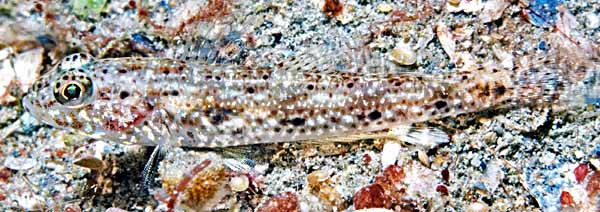Hazeus ammophilus
Allen & Erdmann, 2023
|
Familie: Gobiidae Lokale Bezeichnung |
Typen
Holotypus: WAM P.34854-043 .
Siehe: Eschmeyer, W.N., Fricke, R. & Van der Laan, R. (eds.) 2024. Catalog of Fishes electronic version
Typusfundort: Duduwali Bay, Insel Nuakata, Provinz Milne Bay, Papua Neuguinea, 10°17.351'S, 151°00.334'E [ (Karte)].
Etymologie
Ammophilus (= Sand liebend), als Hinweis auf den Lebensraum in der Sandboden Zone.
Verbreitung
Papua Neuguinea, Indonesien (Anambas Inseln, Südchinesisches Meer und Provinz West-Papua), Philippinen (Luzon und Papawan), und Ryukyu Inseln (Japan). Tiefenbereich: 2-35 m.
IUCN Status

EX Extinct (ausgestorben)
EW Extinct in the Wild (in der Natur ausgestorben)
CR Critically Endangered (vom Aussterben bedroht)EN Endangered (stark gefährdet)
VU Vulnerable (gefährdet)
NT Near Threatened (potenziell gefährdet)
LC Least Concern (nicht gefährdet)
RE Regionally Extinct (regional oder national ausgestorben)DD Data Deficient (ungenügende Datengrundlage)
NE Not Evaluated (nicht beurteilt)
Status: Stand 7.07.2021: NE Not Evaluated (nicht beurteilt)
Gefahren für diese Art: (nicht beurteilt)
Literatur
- Senou, H., Suzuki, T., Shibukawa, K. & Yano, K. 2004. A photographic guide to the gobioid fishes of Japan. Heibonsha Co., Tokyo, Japan, 536 pp. Zitatseite [: 198f, Ryukyu Inseln, als Oplopomops sp.]
- Allen, G.R. & Erdmann, M.V. 2021. Description of two new sand-dwelling gobies (Gobiidae: Hazeus) from the tropical western Pacific Ocean. aqua, International Journal of Ichthyology, 27 (2): 37-56. (Abstract) Zitatseite [: 39, Figs 1-9, ungültige Online-Beschreibung ohne ZooBank Registrierung]
- Allen, G.R. & Erdmann, M.V. 2023. Validation of Hazeus ammophilus and H. profusus Allen & Erdmann (Gobiiformes: Gobiidae) from the tropical western Pacific Ocean. Zootaxa, 5374 (1): 148–150. (doi) Zitatseite [:, !!, Validierung der Beschreibung von 2021]
- Allen, G.R., Erdmann, M.V. & Brooks, W.M. 2024. Hazeus paucisquamatus, a new sand-dwelling goby (Teleostei: Gobiidae) from Papua New Guinea. Journal of the Ocean Science Foundation, 41: 1-11. (doi) Zitatseite [:10, Fig 8a, Farbfoto, Vergleich]
